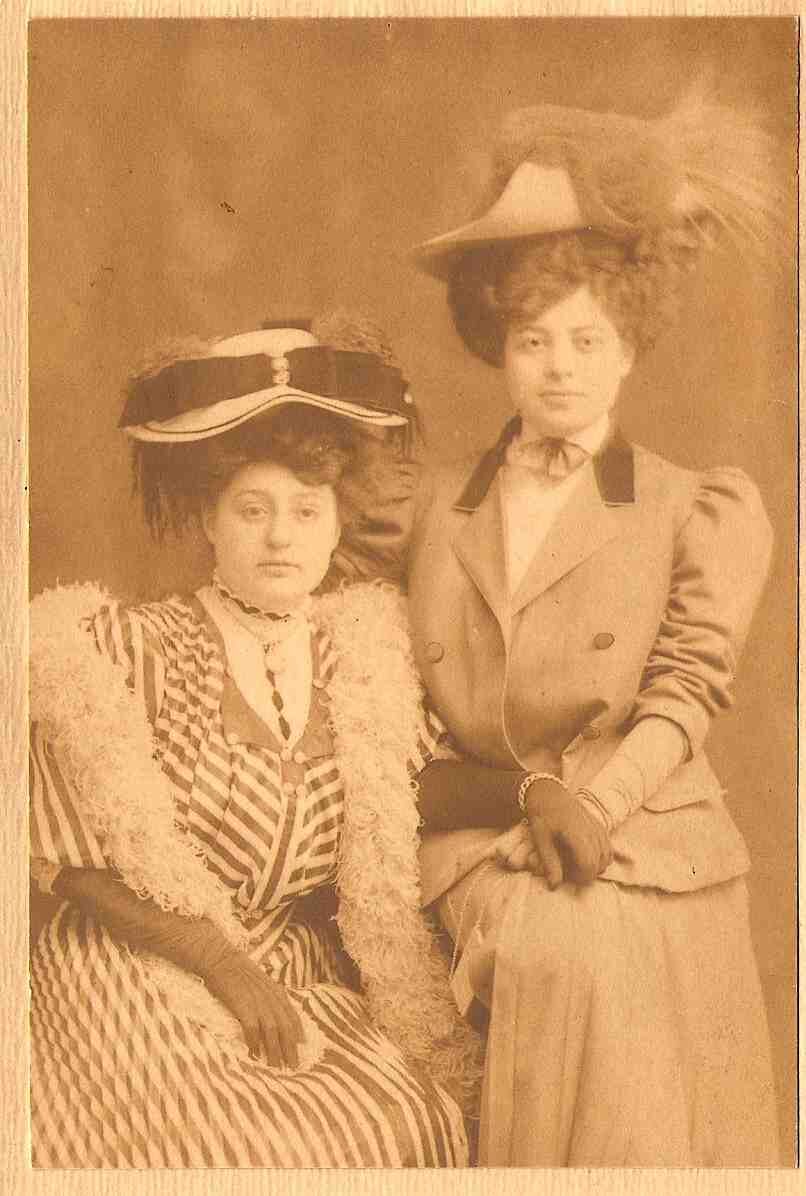I was four years old, an only child with pigtails and buck teeth, when my father issued me with an ultimatum. “Step on Granny Malca’s toes one more time, and I’ll spank you.” By then my grandmother Malca, a refugee from Jewish Lithuania, was in her early eighties and inclined to ribbons and satin. With no regard for my grandmother and her forlorn history, I placed my child’s foot firmly on her shiny patent leather shoe. My interest was to find whether my father would make good on his promise. He did. My transgression and its consequences form my only memory of my grandmother while she was still able to recall my name and her origins.
Even in her old age, Malca Kirsch, née Cossman, subscribed to fashion. In the earliest photo I have of my paternal grandmother (seated) and her older sister, Elca, the orphan sisters are newly arrived in Montreal c. 1900 and sporting the stylish feathers of ostrich and egret, all the while shunning the more curious vogue for hats with owls’ heads and whole hummingbirds.
“Malca’s uncle Archie, her mother’s brother, sent for her from New York,” my mother told me. “He was a doctor.” Decades after my grandmother’s death in 1967, my mother wondered, “Malca, how did she get from New York to Montreal?” Even before my mother developed dementia in her later years, she committed her thoughts to paper—a safeguard against forgetting what mattered most. She therefore didn’t ask the question about Malca aloud but instead scribbled it on a pad belonging to my father, a doctor named “Archie.”
To obtain mating feathers for the millinery trade, hunters slaughtered male and female birds in rookeries from Maine down to Florida, leaving the orphaned offspring to fend for themselves. I haven’t been able to discover how Malca’s parents died in the Kaunas region of Lithuania—from illness, I imagine, or in the pogroms—but Malca compensated for the abandonments of her early life by marrying early and giving birth to three sons, my father being the last. For her youngest son’s bar mitzvah in 1928, my grandmother wore a French gown of green transparent velvet with gold lace and a corsage of orchids. Feathers, by then, had gone out of vogue.
During my early childhood in the 1960s, my great aunt Elca relocated to Miami, whereas my grandmother Malca dedicated herself to my nurturance. She gave me money when I turned one, a tricycle when I turned three, cash when I turned two, four and five. By the time I turned six, she’d lost her memory and no gift was forthcoming. That summer I was disco dancing outdoors and in broad daylight in Cape Cod, wearing a dark two-piece bathing suit, the top piped in white. Malca always told my mother, “Fine feathers make the bird.”
Few believed more strongly in the transformative power of clothing. Having failed to produce a daughter, Malca dressed my father, her youngest, as a girl, allowing his downy curls to grow unchecked. Simon, her husband, apparently didn’t intervene. A botanist, one of the first Jewish faculty members at McGill University, and for a time a researcher at the US Forest Service in Wisconsin, my grandfather taught his sons respect for the fossils of seed-bearing plants. But his wife, he rated merely as an accomplished homemaker, a balabusta with expertise in stuffing verenikes and plucking fowl.
To say my father similarly underestimated his mother isn’t to deny his affection for her. When the young Archie, newly graduated in medicine, volunteered to serve as an army doctor in the war against Germany, his Jewish background put him especially at risk. In a photo taken overseas during the Second World War, Malca’s pendant of several graduated leaves (seen here) is visible around my father’s neck—a talisman for precarious times.
During my early childhood, when other little girls came to play at my house, we invariably took out Malca’s fox stole, kept under the vinyl banquette in the basement. All of my dress-up clothes resided there: the stole, along with my mother’s wedding veil and crinoline and pale pink satin shoes with kitten heels. The desiccated vulpine was reddish brown, with the brush and face forming a clasp round the front. The eye sockets lacked for eyes, the muzzle was locked in a grimace.
The years of Malca’s waning competence were troubling for my family. My mother’s sister died suddenly at twenty-seven after having lost an unborn child. Malca, no longer able to care for herself, had to be moved from her own home. My mother took me with her to the vacated apartment as she crated paintings and bagged up clothing soaked with urine. “Your grandmother adored you,” my mother said, brandishing a yellow rubber glove. The largest painting in the apartment depicted a solider in khakis pointing his rifle at a little girl. Decades later, when the painting became mine, I realized the solider was leaving his daughter to go to war and this was perhaps a final parting.
The last time I saw my grandmother she’d been committed to the dementia unit at a Jewish hospital in Montreal. She looked at me and my mother without recognition. The clothing she wore was stained and not her own.


Comments are closed.